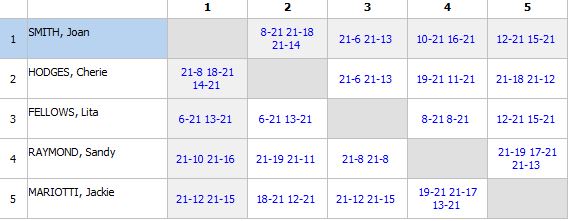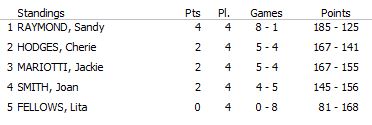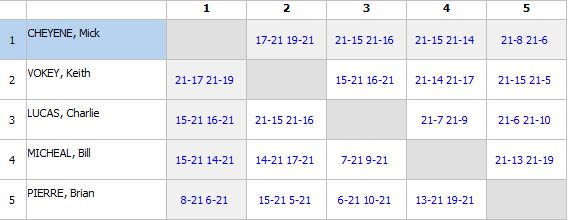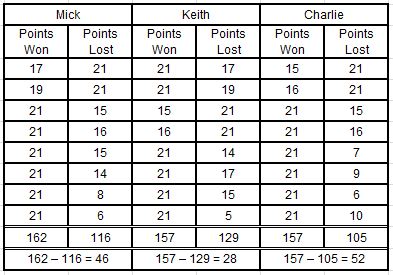Tie Breaking Procedure
RULES FOR DETERMINING WINNERS IN ROUND-ROBIN COMPETITION
(Interpretation of BWF Statutes, Chapter 5, Sect 5.1 General Competition Regulations, Article 16.2)
Resolving a two-way tie:
Article16.2.2 – If two players/ pairs have won the same number of matches, the winner of the match between them will be ranked higher.
Resolving a three-way tie:
Article 16.2.3 – If three or more players/ pairs have won the same number of matches, ranking will be established by the difference between total games won and total games lost, with greater difference ranked higher.
Article 16.2.3.1 – If this still leaves two players/ pairs equal, the winner of the match between them will be ranked higher.
Article 16.2.4 – If three or more players / pairs have won the same number of matches and are equal in the difference between total games won and total games lost, ranking will be established by the difference between total points won and total points lost, with greater difference ranked higher.
Article 16.2.4.1 – If this still leaves two players/ pairs equal, the winner of the match between them will be ranked higher.
Article 16.2.4.2 – If after all procedures have been followed, a tie still exists, then the players in the tie will each be given equal standing and ranking for the tournament.
Below are different scenarios in which the above procedure would be implemented
Resolving a two-way tie:
Article16.2.2 – If two players/ pairs have won the same number of matches, the winner of the match between them will be ranked higher. That is, if Paul and Art are tied but Paul beat Art in their match, then Paul is placed ahead of Art.
Resolving a three-way tie:
EXAMPLE 1
 |
Joan 2 wins – 2 losses Cherie 2 wins – 2 losses Lita 0 wins – 4 losses Sandy 4 wins – 0 losses Jackie 2 wins – 2 losses |
| Screen shot above from Tournament Planner software |
In the example above, Sandy is the clear winner as she won all matches.
Joan, Cherie and Jackie each won 2 and lost 2 matches, thus there is a three-way tie for second place therefore Article 16.2.3 is applied
Step 1: Article 16.2.3 – If three or more players/ pairs have won the same number of matches, ranking will be established by the difference between total games won and total games lost, with greater difference ranked higher.
 |
| Screen shot above from Tournament Planner Software |
In this case:
- Joan has won 4 games and lost 5 for a difference of -1
- Cherie has won 5 games and lost 4 for a difference of 1
- Jackie has won 5 games and lost 4 for a difference of 1
Cherie and Jackie are tied but ahead of Joan who is therefore third. As Cherie and Jackie are still tied Article 16.2.3.1 is applied
Step 2: Article 16.2.3.1 – If this still leaves two players/ pairs equal, the winner of the match between them will be ranked higher.
Cherie beat Jackie therefore Cherie is placed higher.
Based on this result the final standings are

Screen shot above from Tournament Planner software
Resolving a three way tie:
EXAMPLE 2

Screen shot above from Tournament Planner Software |
Mick: 3 Wins- 1 Loss Keith: 3 Wins – 1 Loss Charlie: 3 Wins – 1 Loss Bill: 1 Win – 3 Losses Brian: 0 Wins – 4 Losses |
In this example, Mick, Keith and Charlie are tied for first place with 3 wins and 1 lose. Applying Article 16.2.3 and Article 16.2.3.1 does not resolve the tie as each player has won 6 games and lost 2.
- Mick won 6 games and lost 2
- Keith won 6 games and lost 2
- Charlie won 6 games and lost 2
Therefore Article 16.2.4 has to be applied.
Article 16.2.4 – If three or more players / pairs have won the same number of matches and are equal in the difference between total games won and total games lost, ranking will be established by the difference between total points won and total points lost, with greater difference ranked higher.
 |
| Screen shot above from Tournament Planner Software |
Based on this result, the final standings are Charlie is first, followed by Mick and then Keith

Screen shot above from Tournament Planner software